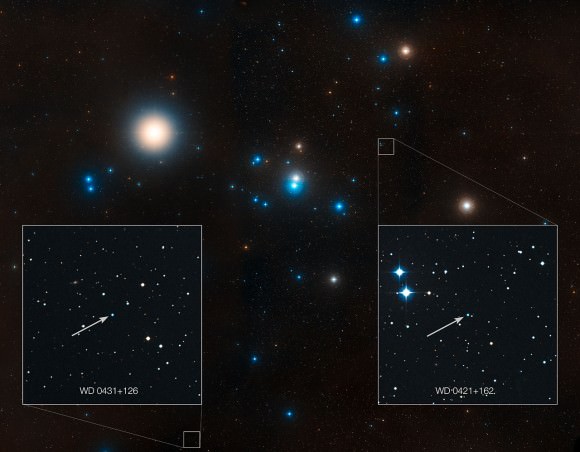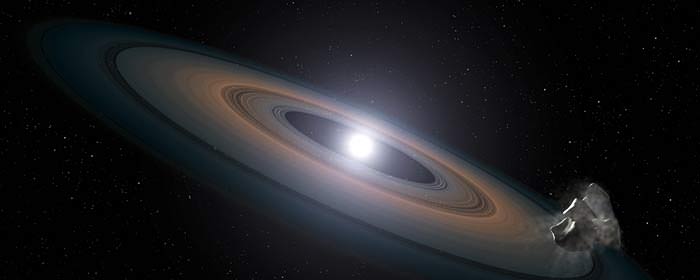For those of us who practice amateur astronomy, we’re very familiar with the 150 light-year distant Hyades star cluster – one of the jewels in the Taurus crown. We’ve looked at it countless times, but now the NASA/ESA Hubble Space Telescope has taken its turn observing and spotted something astronomers weren’t expecting – the debris of Earth-like planets orbiting white dwarf stars. Are these “burn outs” being polluted by detritus similar to asteroids? According to researchers, this new observation could mean that rocky planet creation is commonplace in star clusters.
“We have identified chemical evidence for the building blocks of rocky planets,” said Jay Farihi of the University of Cambridge in England. He is lead author of a new study appearing in the Monthly Notices of the Royal Astronomical Society. “When these stars were born, they built planets, and there’s a good chance they currently retain some of them. The material we are seeing is evidence of this. The debris is at least as rocky as the most primitive terrestrial bodies in our solar system.”
So what makes this an uncommon occurrence? Research tells us that all stars are formed in clusters, and we know that planets form around stars. However, the equation doesn’t go hand in hand. Out of the hundreds of known exoplanets, only four are known to have homes in star clusters. As a matter of fact, that number is a meager half percent, but why? As a rule, the stars contained within a cluster are young and active. They are busy producing stellar flares and similar brilliant activity which may mask signs of emerging planets. This new research is looking to the “older” members of the cluster stars – the grandparents which may be babysitting.
To locate possible candidates, astronomers have employed Hubble’s Cosmic Origins Spectrograph and focused on two white dwarf stars. Their return showed evidence of silicon and just slight levels of carbon in their atmospheres. This observation was important because silicon is key in rocky materials – a prime ingredient on Earth’s list and other similar solid planets. This silicon signature may have come from the disintegration of asteroids as they wandered too close to the stars and were torn apart. A lack of carbon is equally exciting because, while it helps shape the properties and origins of planetary debris, it becomes scarce when rocky planets are formed. This material may have formed a torus around the defunct stars which then drew the matter towards them.
“We have identified chemical evidence for the building blocks of rocky planets,” said Farihi. “When these stars were born, they built planets, and there’s a good chance they currently retain some of them. The material we are seeing is evidence of this. The debris is at least as rocky as the most primitive terrestrial bodies in our solar system.”
Ring around the rosie? You bet. This leftover material swirling around the white dwarf stars could mean that planet formation happened almost simultaneously as the stars were born. At their collapse, the surviving gas giants may have had the gravitational “push” to relocate asteroid-like bodies into “star-grazing orbits”.

Inset, the locations of these white dwarf stars are indicated — stars known as WD 0421+162, and WD 0431+126. Credit: NASA, ESA, STScI, and Z. Levay (STScI)
“We have identified chemical evidence for the building blocks of rocky planets,” explains Farihi. “When these stars were born, they built planets, and there’s a good chance that they currently retain some of them. The signs of rocky debris we are seeing are evidence of this — it is at least as rocky as the most primitive terrestrial bodies in our Solar System. The one thing the white dwarf pollution technique gives us that we won’t get with any other planet detection technique is the chemistry of solid planets. Based on the silicon-to-carbon ratio in our study, for example, we can actually say that this material is basically Earth-like.”
What of future plans? According to Farihi and the research team, by continuing to observe with methods like those employed by Hubble, they can take an even deeper look at the atmospheres around white dwarf stars. They will be searching for signs of solid planet “pollution” – exploring the white dwarf chemistry and analyzing stellar composition. Right now, the two “polluted” Hyades white dwarfs are just a small segment of more than a hundred future candidates which will be studied by a team led by Boris Gansicke of the University of Warwick in England. Team member Detlev Koester of the University of Kiel in Germany is also contributing by using sophisticated computer models of white dwarf atmospheres to determine the abundances of various elements that can be traced to planets in the Hubble spectrograph data.
“Normally, white dwarfs are like blank pieces of paper, containing only the light elements hydrogen and helium,” Farihi said. “Heavy elements like silicon and carbon sink to the core. The one thing the white dwarf pollution technique gives us that we just won’t get with any other planet-detection technique is the chemistry of solid planets.”
The team also plans to look deeper into the stellar composition as well. “The beauty of this technique is that whatever the Universe is doing, we’ll be able to measure it,” Farihi said. “We have been using the Solar System as a kind of map, but we don’t know what the rest of the Universe does. Hopefully with Hubble and its powerful ultraviolet-light spectrograph COS, and with the upcoming ground-based 30- and 40-metre telescopes, we’ll be able to tell more of the story.”
And we’ll be listening…
Original Story Source: Hubble News Release.


Here’s the relevant paper (PDF):
Evidence of Rocky Planetesimals Orbiting Two Hyades Stars.
This is all kinds of nice!
– The confirmation that planet systems survives in cluster environment is perhaps expected as the article lays out, and we now know planets are found in the most unexpected precarious places. But it is always nice to have more tests.
– Above all, the observation of volatile poor terrestrial material like our own habitable planets (Earth, early Mars) outside our system. It isn’t quite as carbon poor as bulk Earth [thanks Ivan3man!], but on the same accretionary and differentiating trajectory.
Having the first observations being volatile poor should mean that dry habitables are common, despite the Kepler observations of mostly water worlds. There is a selection bias in Kepler observations since water worlds have larger radius (lower density). Maybe that is what we are seeing akin to the early hot Jupiters of Kepler.
Speaking of water, hydrogen isotope ratios are now telling us, arguably, that the Earth and Moon water had the same pre-collision source:
“By showing that water on the moon and Earth came from the same source, this new study offers yet more evidence that the moon’s water has been there all along, or nearly so.
“The simplest explanation for what we found is that there was water on the proto-Earth at the time of the giant impact,” said Alberto Saal, a geochemist at Brown University and the study’s lead author. “Some of that water survived the impact, and that’s what we see in the moon.”
Or, the proto-moon and proto-Earth were showered by the same family of carbonaceous chondrites soon after they separated, said James Van Orman, professor of earth, environmental and planetary sciences at Case Western Reserve, and a co-author.”
I assume the matching ratios and matching amounts are simpler to predict from a pre-collision scenario, but that the question is still wide open. In any case, it hints that once dry planets can stay dry, despite being bombarded by clearing debris disks and developing Oort clouds (giant migration, late bombardment et cetera).
This material seems to be the result of planets having been demolished by the red giant phase of the star. A planet situated in an orbit that prevents it from being completely absorbed by the dying star might be converted into a debris ring. Maybe this is the fate of the Earth, or some material therein, or maybe Mars.
LC
zzzzzzzzzzzzzzzzzzzzzzzzzzzzzzzzzzzzzz What what I fell asleep/